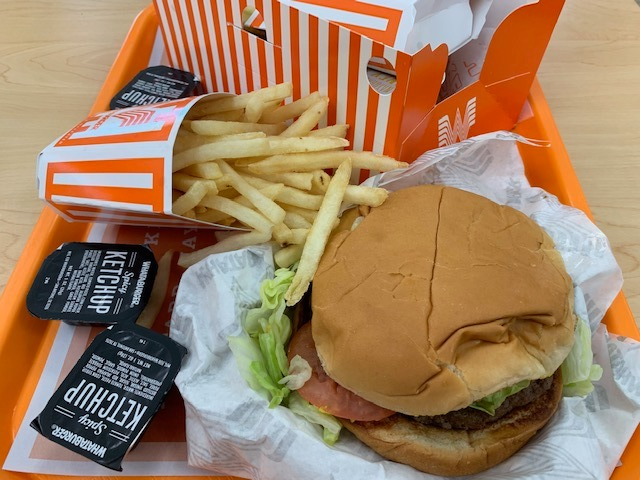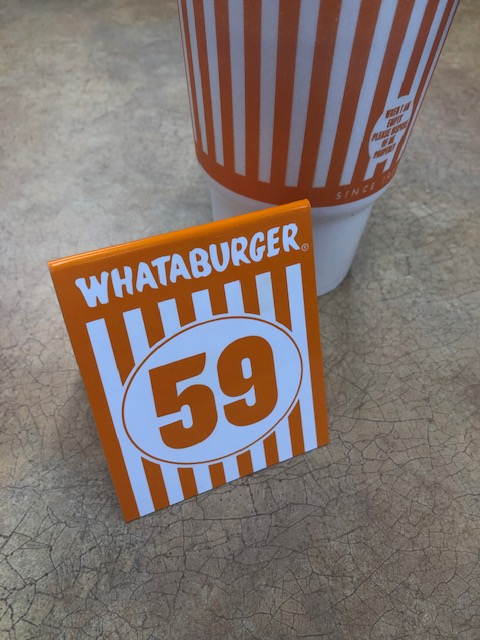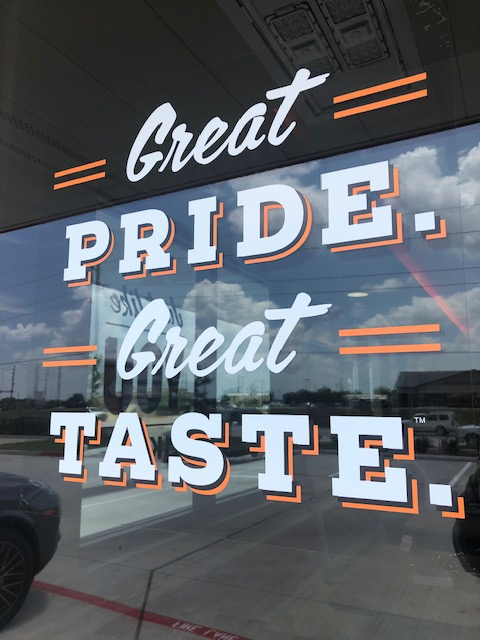By: Michele Wood
They say everything’s bigger in Texas, and that seems to include the brand loyalty to Texas-born products. If you are a Texan, or you know Texans, you have probably heard them extoll the incomparable virtues of Whataburger. Texans not only prefer Whataburger to other fast food options, they are willing to go down, Alamo-style, defending it. As one Vice News columnist writes, “They will pry my Honey Butter Chicken Biscuit from my cold, dead hands.”
What is it about Whataburger that has inspired such devotion? To understand, we need to look back at the history of the founder, Harmon Dobson, and how he came to build the quintessential Texas burger company. Like many great Texans, Dobson was born somewhere else. He grew up on a small farm in Arkansas and started college at the University of Missouri. Unfortunately, the pressures of the Great Depression were too great on the farm so Dobson had to drop out and return home to help.
Once the farm was stable, he began a decade of traveling adventures, starting as an apprentice iron worker in 1934, moving on to shipbuilding in New York at the start of World War II, and then to North Africa in 1942 to do pipefitting, scrapyard work, and cable rigging for Bell Telephone. In what is now Eritrea, Dobson was hired to help build a naval base where he worked on hangars, radio towers, and tanks. The work was so intense that his typically-wordy journal entries often only contained a single entry for the day: “Worked.”
Dobson next went to Egypt to work on the Suez Canal, and then he was off to Bahrain to help build an oil refinery. It was in Bahrain that he was put in charge of mess hall construction and management, getting his first exposure to food service, providing over 750 meals per day.
When the war ended in 1945, he gratefully returned home to Arkansas. Once stateside, Dobson’s entrepreneurial instincts blossomed. Realizing that returning GI’s would need cars, but that manufacturers were behind in retrofitting factories from military production, he began buying up used cars. Soon he had a profitable used car business.
With the dealership profits he bought into a quarry, and then used income from that to begin oil prospecting. He expanded his car dealership to include truck fleets, and got himself a pilot’s license and his own small plane, which helped him travel back and forth to his businesses.
1950 proved to be an auspicious year for Dobson. He was traveling to Texas occasionally to invest in more oil ventures, and he was getting familiar with the state. It was in this year that he decided to partner with hamburger expert Paul Burton to create a burger stand. Burton and Dobson scouted locations for their new business, eventually deciding on Corpus Christi along the Gulf Coast.
Corpus made sense for the new venture for several reasons. In 1926, the port opened. In 1941, the largest naval air station in the country was completed there, and in 1950, a causeway connecting Corpus to Padre Island opened, creating a vibrant metro area full of shipping activity, military personnel and families, and tourists headed for the beach.

On August 8, 1950, the very first Whataburger was sold out of a tiny portable stand across from Del Mar College. It cost 25 cents, a price higher than average for burgers at the time, but on their first day, the pair sold 551 burgers.
What made a Whataburger distinctive? At the time, the dominant fast food burger in the country was the tiny White Castle slider. Dobson wanted a Texas-sized alternative, a 5” diameter burger that was so much bigger than the standard that they had to contract with a local bakery to manufacture special pans to accommodate the oversized bun. Dobson wanted people to take their first bite and be prompted to exclaim, “What a burger!” and thus the name was born.
The original burgers were served as they are still today: fresh beef patties, lettuce, four pickles, three slices of tomato, chopped onions, and mustard. Unfortunately, the burgers were so big and successful that Dobson and Burton soon found they were not making a profit at 25 cents. They disagreed about expansion strategies and Dobson ended up buying Burton out with a new Plymouth.
Now with sole control, Dobson hung a sign on the store stating, “Folks, we priced our burgers too low and lost our shirt. Sorry, but we gotta raise the price to 30 cents.” Customers apparently appreciated the straight talk, and two more stores opened in Corpus selling burgers at the high price of 35 cents a piece.
Dobson continued to scout locations for new stores from his plane, often dropping advertisements from the air. In 1952, Joe Adams became the first franchise owner with Store #5 in Alice, Texas. He wrote to Dobson after opening, “People lined up around the window out to the street and down to the Corpus Highway. I wanted you to know, it scared the living hell out of me.”
More stores and franchises opened after that. Dobson preferred to work with family businesses, feeling they would invest more in the quality and success of the store. Number 24 in Odessa became the first of the now iconic A-frame buildings, inspired by the design of airplane hangars and proving to be hurricane-proof. Dobson added the distinctive orange and white stipes to the roof so he could easily spot his stores from air.
In the meantime, a young widow named Grace from Dobson’s hometown in Arkansas had rented a room in an apartment from Dobson’s older brother. Harmon and Grace fell in love, had one of their first dates at the original Whataburger, and married in 1955.
By 1961 there were 17 store locations, but tragedy struck in 1967 when after a stop in La Porte, Dobson went down with his plane and was killed. With a growing business and three young children, Grace was told that she couldn’t possibly manage both and was pressured to sell. Knowing it was Harmon’s wish to keep the business in the family, she held firm and became Chairman of the Board in 1969.

Against many predictions, the business grew under Grace’s leadership. The first drive-thru location opened in 1971, and in 1982, three locations began offering 24-hour service. This year also brought the popular taquitos and “Whatachick’n” to the menu. The brand lost some momentum in the later 80’s, adding too many items to the menu and diluting their strengths. Tom Dobson, Grace’s eldest and Harmon’s son by adoption, took over as CEO in 1993, charged with re-strengthening the brand, which now stretched over 500 stores. The leadership worked and in 2001, a bill was introduced by the State Chair of the Texas Public Health Committee designating Whataburger as a Texas Treasure. It was the same year that the beloved Honey BBQ Chicken Strip Sandwich debuted. In 2005, ‘Lady Grace’ Dobson passed away, and in 2008, following Hurricane Ike’s devastation of the Texas coast, Whataburger’s headquarters were moved to San Antonio.
Today, Whataburger has 828 locations in 10 states with 600 locations in Texas alone. The most recent sales figures report $2.4 billion in sales. For scale, that is $1.5 billion more than oft-cited rival In-N-Out Burger. According to data from Technomic, Whataburger’s sales have grown by 52% over the past five years. It is the 31st largest restaurant chain in the country and its compound annual growth rate over those five years is 8.7%, which is 6.5% higher than the 2.2% average of the quick-serve burger business.
So, what’s so special about Whataburger? Well, another thing that is bigger in Texas is pride of place. Whataburger has committed to maintaining the sense of Texas identity. To emphasize this, they have been partnering with other iconic Texas brands. In 2017, Whataburger collaborated with jewelry company James Avery, based in Kerrville, Texas, to bring an $80 sterling silver charm to customers. That same year they released a stainless steel cup in the original Whataburger cup design, but customers wanted the better quality of cup they were getting from Texas company YETI. Whataburger responded with a partnership to offer exactly that item.
The Texas grocery store behemoth HEB, also based in San Antonio, is a favorite of native and new Texans alike. It’s famous for delivering specific items that Texans crave, which national grocers like Kroger can overlook. In 2013, one of the executives of HEB noticed that people were hoarding packets of Whataburger’s “Fancy Ketchup” and “Spicy Ketchup” to use at home. Like Dobson, he saw an opportunity, and HEB partnered with Whataburger to be the exclusive retailer for bottles of the coveted sauces. Since then, HEB has added Whataburger sausage, hickory-smoked bacon, and pancake mix—all sporting the Whataburger colors on the package. Currently, Whataburger customers can get a Dr. Pepper Shake to go with their Texas-sized burger, another pairing with a Texas-based company. As freelance writer Kelsey McKinney writes, “Whataburger is undeniably, categorically Texan.”

Texans looking to grab a bite after a Friday night high school football game are not the only ones who have noticed the brand’s continued success. In June 2019, audible gasps were heard all across the Lone Star state when BDT Capital announced that it had agreed to acquire a majority interest in Whataburger. BDT is a Chicago-based merchant bank that invests in family and founder-led companies. They have reported plans to expand the business and re-align internal leadership including a new president, COO, and Chief Restaurant Operating Officer. While details of the deal weren’t disclosed, it was reported that the Dobson family will retain minority interest.
Loyal customer fans and Texas football icon JJ Watt were understandably concerned about the announcement. Tweets of alarm appeared as well as impassioned articles of anxiety. Texas Monthly’s Dan Solomon penned an article titled “Whataburger’s Been Sold to the Yanks” right after the announcement, asking “Is it the burgerpocalypse?” He continues, “The Chicago-based company was founded by former Goldman Sachs executive Byron Trott, which sounds like a name straight out of a Vonnegut novel.” Solomon tries to end on a note of optimism, but Texans are always wary of being messed with. He ends the article with “It’s unlikely that the immediate future of Whataburger involves serving Wrigley Field hot dogs at the drive-thru, or for Whataburger to flood the Chicagoland region with orange-and-white striped entry points to burger nirvana—but that’s just a guess, and right now, we just don’t know.”
The potential impact of the BDT acquisition is yet to be seen and franchisees, employees and hungry fans all are hoping for the best. If BDT follows the successful recipe of adding home-grown Texas ingredients to the business, it’s likely to be another win for Whataburger. And like Dobson, outsiders tend to do very well in Texas. As native son Lyle Lovett sings, “That’s right, you’re not from Texas. But Texas wants you anyway.”
